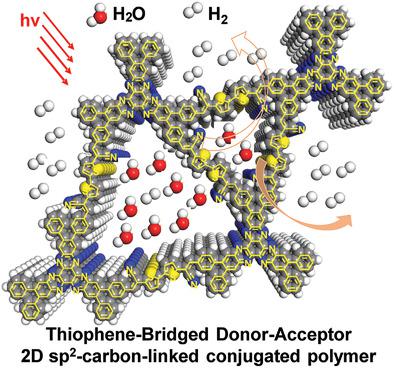当前位置:
X-MOL 学术
›
Adv. Mater.
›
论文详情
Our official English website, www.x-mol.net, welcomes your
feedback! (Note: you will need to create a separate account there.)
Thiophene‐Bridged Donor–Acceptor sp2‐Carbon‐Linked 2D Conjugated Polymers as Photocathodes for Water Reduction
Advanced Materials ( IF 27.4 ) Pub Date : 2020-11-16 , DOI: 10.1002/adma.202006274 Shunqi Xu 1 , Hanjun Sun 1 , Matthew Addicoat 2 , Bishnu P. Biswal 3 , Fan He 4 , SangWook Park 1, 5 , Silvia Paasch 6 , Tao Zhang 1 , Wenbo Sheng 7 , Eike Brunner 6 , Yang Hou 4 , Marcus Richter 1 , Xinliang Feng 1
Advanced Materials ( IF 27.4 ) Pub Date : 2020-11-16 , DOI: 10.1002/adma.202006274 Shunqi Xu 1 , Hanjun Sun 1 , Matthew Addicoat 2 , Bishnu P. Biswal 3 , Fan He 4 , SangWook Park 1, 5 , Silvia Paasch 6 , Tao Zhang 1 , Wenbo Sheng 7 , Eike Brunner 6 , Yang Hou 4 , Marcus Richter 1 , Xinliang Feng 1
Affiliation

|
Photoelectrochemical (PEC) water reduction, converting solar energy into environmentally friendly hydrogen fuel, requires delicate design and synthesis of semiconductors with appropriate bandgaps, suitable energy levels of the frontier orbitals, and high intrinsic charge mobility. In this work, the synthesis of a novel bithiophene‐bridged donor–acceptor‐based 2D sp2‐carbon‐linked conjugated polymer (2D CCP) is demonstrated. The Knoevenagel polymerization between the electron‐accepting building block 2,3,8,9,14,15‐hexa(4‐formylphenyl) diquinoxalino[2,3‐a:2′,3′‐c]phenazine (HATN‐6CHO) and the first electron‐donating linker 2,2′‐([2,2′‐bithiophene]‐5,5′‐diyl)diacetonitrile (ThDAN) provides the 2D CCP‐HATNThDAN (2D CCP‐Th). Compared with the corresponding biphenyl‐bridged 2D CCP‐HATN‐BDAN (2D CCP‐BD), the bithiophene‐based 2D CCP‐Th exhibits a wide light‐harvesting range (up to 674 nm), a optical energy gap (2.04 eV), and highest energy occupied molecular orbital–lowest unoccupied molecular orbital distributions for facilitated charge transfer, which make 2D CCP‐Th a promising candidate for PEC water reduction. As a result, 2D CCP‐Th presents a superb H2‐evolution photocurrent density up to ≈7.9 µA cm−2 at 0 V versus reversible hydrogen electrode, which is superior to the reported 2D covalent organic frameworks and most carbon nitride materials (0.09–6.0 µA cm−2). Density functional theory calculations identify the thiophene units and cyano substituents at the vinylene linkage as active sites for the evolution of H2.
中文翻译:

噻吩桥式供体-受体 sp2-碳连接的 2D 共轭聚合物作为光阴极面用于减水
光电化学 (PEC) 水还原,将太阳能转化为环保氢燃料,需要精密设计和合成具有适当带隙、适当前沿轨道能级和高本征电荷迁移率的半导体。在这项工作中,展示了一种新型的二噻吩桥式供体-受体-基于 2D sp2-碳-连接共轭聚合物 (2D CCP) 的合成。接受电子的结构单元 2,3,8,9,14,15-六(4-甲酰基苯基)二喹吾吾[2,3-a:2′,3′-c]吩嗪 (HATN-6CHO) 和第一个电子供体接头 2,2′‐([2,2′‐联噻吩]‐5,5′‐二基)二乙腈 (ThDAN) 之间的 Knoevenagel 聚合提供了 2D CCP-HATNThDAN (2D CCP‐Th)。与相应的联苯桥式 2D CCP-HATN-BDAN (2D CCP-BD) 相比,基于联噻吩的 2D CCP-Th 表现出较宽的光捕获范围(高达 674 nm)、光能隙 (2.04 eV) 和最高能量占据的分子轨道-最低的未占据分子轨道分布,以促进电荷转移,这使得 2D CCP-Th 成为 PEC 减水的有前途的候选者。因此,与可逆氢电极相比,2D CCP-Th 在 0 V 时表现出高达 ≈7.9 μA cm-2 的出色 H2 析出光电流密度,优于已报道的 2D 共价有机框架和大多数氮化碳材料 (0.09–6.0 μA cm-2)。密度泛函理论计算确定了乙烯基键处的噻吩单元和氰基取代基是 H2 进化的活性位点。
更新日期:2021-01-04
中文翻译:

噻吩桥式供体-受体 sp2-碳连接的 2D 共轭聚合物作为光阴极面用于减水
光电化学 (PEC) 水还原,将太阳能转化为环保氢燃料,需要精密设计和合成具有适当带隙、适当前沿轨道能级和高本征电荷迁移率的半导体。在这项工作中,展示了一种新型的二噻吩桥式供体-受体-基于 2D sp2-碳-连接共轭聚合物 (2D CCP) 的合成。接受电子的结构单元 2,3,8,9,14,15-六(4-甲酰基苯基)二喹吾吾[2,3-a:2′,3′-c]吩嗪 (HATN-6CHO) 和第一个电子供体接头 2,2′‐([2,2′‐联噻吩]‐5,5′‐二基)二乙腈 (ThDAN) 之间的 Knoevenagel 聚合提供了 2D CCP-HATNThDAN (2D CCP‐Th)。与相应的联苯桥式 2D CCP-HATN-BDAN (2D CCP-BD) 相比,基于联噻吩的 2D CCP-Th 表现出较宽的光捕获范围(高达 674 nm)、光能隙 (2.04 eV) 和最高能量占据的分子轨道-最低的未占据分子轨道分布,以促进电荷转移,这使得 2D CCP-Th 成为 PEC 减水的有前途的候选者。因此,与可逆氢电极相比,2D CCP-Th 在 0 V 时表现出高达 ≈7.9 μA cm-2 的出色 H2 析出光电流密度,优于已报道的 2D 共价有机框架和大多数氮化碳材料 (0.09–6.0 μA cm-2)。密度泛函理论计算确定了乙烯基键处的噻吩单元和氰基取代基是 H2 进化的活性位点。






























 京公网安备 11010802027423号
京公网安备 11010802027423号